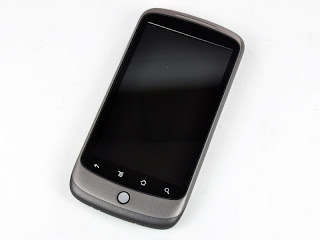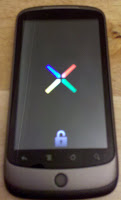Quite a few of my friends, especially in the mobile industry, have aquired Nexus One's recently and more often than not it is their first foray into the world of Android.

Over the last couple of days I've been asked to help set several of them up with my preferred settings, applications, games, etc... So I'll maintain this post and from now on I can point people here.
First BootFirst and most importantly is that if you have multiple G-Mail and Google Apps accounts, make sure you sign in with your 'primary' one first. The N1 may have multiple GMail account support but it will only sync one calendar, the first one you enter. Also the first sync is going to use a whole bunch of data, so best to be on wifi.
If you received your Nexus 1 at MWC 2010 it will now inform you that a firmware update is ready. This update adds multi-touch support to the Browser, Gallery and Google Maps, go for it, it doesn't take long.
Android Usage HintsNotification Bar - Top of the screen where the clock and battery level resides. New notifications from the apps on your phone will appear here. To see the detail of the notifications just drag the bar down.
Menu Button - On the N1 it is the second button in, above the trackball, with the 4 lines on it. Most apps have a Menu and this button makes it appear. Holding the button for a second also forces the On Screen Keyboard to appear, which can be a useful override at times.
Home Button - A bit like the button on the iPhone, always gets you back to your home screen. Hold it down to view the last 6 apps that you've run. These aren't necessarily still running.
Long Press - One of the interaction metaphors in Android, especially on items shown in a list. It is akin to the right click in Windows. Just touch and hold an item for a couple of seconds and sometimes a context sensitive menu will appear.
Stars - Look for small stars in the top right of UI's. They appear in G-Mail (you should know about them there for 'starring' mails), but they also appear on Google Maps for saving favourties if you long press on a location and touch the address bubble. Another place is in contacts, you can star a contact and then add a live-folder called 'Starred Contacts' to your home screen, keeping the most contacted people easy to access.
Widgets - Android allows Widgets to be displayed on all 5 of your N1's home screens. Press the 'Menu' button, then Add, Widgets. If the 'Add' button is greyed out then you probably don't have enough space on the current home screen to add another widget, try swiping to another one first.
Shortcuts - You can easily add shortcuts on your home screens, not only to apps but also Contacts, Bookmarks, etc. Go to Menu, Add, Shortcuts
Folders - Very handy at keeping related shortcuts together. I have a Games folder on my desktop with shortcuts to all my games in it. To change the name of a folder, open it then long press on the current name, a change name dialog will appear.
Google Search box / Search button: This little box or button can do a whole lot. It searches contacts, applications and the internet. Try it out, also supports voice search.
SettingsYou can find your Nexus's settings by pressing the 'Menu' button, then selecting 'Settings'. For example I go into Settings -> Wireless & Networks -> Wi-Fi Settings -> Press 'Menu' Button -> Advanced -> Wi-Fi sleep policy, and set it to Never as I have issues with the N1 failing to reconnect to our office Network. Then I manage when wifi is on or off with the pre-installed 'Power Control' home screen widget.
Auto Screen Brightness is useful at getting the best out of the N1's OLED screen and battery life, it is in Settings -> Sound & Display -> Brightness -> Automatic brightness
Allow non-market application downloading/side-loading by going to Settings -> Applications -> Unknown sources
Add a little security to your N1 by setting an unlock pattern in Settings -> Locations & Security -> Set unlock pattern. If you enter the wrong pattern too many times the phone locks up until you re-enter your G-Mail password.
Check for System updates from time to time in Settings -> About Phone -> System Updates
Also in 'About Phone' there is an item 'Battery use' which shows you a breakdown of which apps are using the most battery.
ApplicationsMarket: This is your app-store now, get used to it. All the following apps are in there somewhere. NOTE: If you don't have a SIM card in your phone, or if the Android Market doesn't support payments in your country you will not see any paid apps. It's a feature.
Google Maps: Updates to this are delivered via the Market, the latest update right now includes Multi-Touch and Google Buzz.
Google Listen: Number 1 podcasting app for Android, search for your podcasts or import them and let it get on with it.
beebPlayer: iPlayer for UK Android users, awesome, amazing, thank you.
Weather Widget - Free by Android Apps: In my opinion the best looking weather widget in the Market, I use the 2x1 'Weather Small' varient.
Barcode Scanner: QR Codes are a decent way of transferring data between devices, if this is installed you can not only scan QR Codes but also create them from Contacts, Clipboard, Bookmarks or Applications.
Seesmic: My current fave Twitter client for Android
Flickr Droid: One of several Flickr uploaders, does a decent enough job and adds a Share to Flickr intent into the Gallery sharing options.
London City / London Tube: Both very valuable for someone who uses the London Underground frequently. Between them you get a decent map, line status's, routing and live departure boards (as widgets!)
Qik: If you're into Qik'ing, then the Android client is solid.
gTasks: Syncs with your G-Mail tasks lists if you have any.
Battery Widget: (Yes it is one of mine) I like to know the exact battery level so I have this widget on one of my screens.
Tech/News/Gossip/Gaming Buzz Widgets & Buzz Deck: A set of Widgets/Apps from us at Mippin to keep you upto date with the latest news in your chosen category.
Astro: My favourite file manager for Android, always in beta but works well.
MP3 Store: The Amazon MP3 store is preinstalled on the N1, has previews, special offers and can be a tad dangerous when drunk.
Shazam, Ultimate Stopwatch (me again), Compass, Urban Spoon, i-Music, Google Googles are all also worth checking out
GamesTower Defence games have taken off well on Android and there are quite a few around. The original was Plox, it is a year old now but worth a bash, the most popular is Robo Defence.
There are also many 'Flight Control' style games, my fave right now is 'Air Control', smooth gameplay, online scores and suitably difficult.
My top 3D games right now are Raging Thunder, Iron Sight, Breakout Legend
I still also like a good card game, there are loads.
Live WallpapersThe Nexus 1 is the first Android device to support animated, interactive Wallpapers. Check out the preinstalled ones by pressing the 'Menu' Button, then Wallpaper, and Live wallpapers.
There are quite a few new ones now in the market including the 'Digital Rain' from the Matrix and my favourite 'Starfield 3D' which includes double tap for Hyper-space! I've knocked up 'Duck Paper' which is a Duck Hunt based Live Wallpaper, also available in the Market. We're intending on knocking a few more of these out over the next few weeks.
Rooting / Jail breaking
If you're top of your techy game and fancy being able to perform some more advanced functions on your Nexus 1 you need to get root access. Once done you'll be able to install apps for wired tether, wireless tether, screenshot, strobe light, boot animations, Apps to SD, no limits. You'll have super-user root access to your device in the terminal as well. The first stage of gaining root access is to unlock your bootloader, enabling the install of custom ROMs. Google were very clever about this and provided a simple method for doing it, but it warns you it will invalidate your warrenty and place an open padlock onto your boot screen.
I followed the guide over at Android & Me:
http://androidandme.com/2010/01/hacks/video-how-to-unlock-and-root-a-nexus-one/Thanks for reading and happy Android'ing


 I've recently been asked a couple of times by new Android developers how 'Tech Buzz Widget' manages to overlay itself ontop of the desktop, allowing your wallpaper to show through. Assuming that it is easier to Google the answer than ask me, it may be somethiing that there isn't enough detail on already. So here is my 10 cents.
I've recently been asked a couple of times by new Android developers how 'Tech Buzz Widget' manages to overlay itself ontop of the desktop, allowing your wallpaper to show through. Assuming that it is easier to Google the answer than ask me, it may be somethiing that there isn't enough detail on already. So here is my 10 cents.





